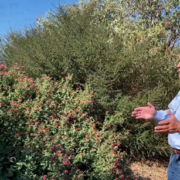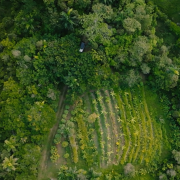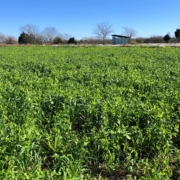Urban Agroforestry: Bringing the Jungle Back to the Concrete Jungle
 Print This Post
Print This Post
By Katherine Favor, NCAT Sustainable Agriculture Specialist
Cities are notorious for being devoid of flora and fauna. They don’t call it the concrete jungle for nothing! But it doesn’t have to be that way. In this blog, we’re going to talk about how we can bring a little bit of jungle back to the concrete jungle with something called urban agroforestry.
Urban agroforestry is the intentional use of perennial trees and shrubs to improve the sustainability and resilience of urban farms and communities. Urban areas often deal with issues such as pollution, water contamination, heavy metal buildup in soils, the heat island effect, stormwater and runoff issues, lack of habitat for wildlife, a lack of connection to nature for humans, and food insecurity. Trees can be used to address many of these issues. Whether on urban farms, in parks, in residential areas, or in other urban areas, there many ways you can utilize trees in an urban setting, depending on your goals. Let’s explore a few examples of urban areas in Texas that are utilizing urban agroforestry.
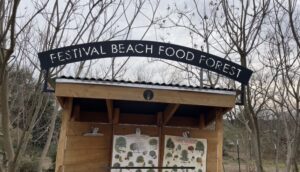
Festival Beach Food Forest. Photo: Katherine Favor, NCAT
Festival Beach Food Forest, Austin, Texas
Festival Beach is a public park in the heart of downtown Austin, Texas, that was converted into a food forest in 2014. Food forests are sometimes called multifunctional woody polycultures, edible forest gardens, or edible perennial landscapes. All these terms refer to food-producing systems designed in ways that mimic forest ecosystems, with multiple vertical layers of perennial and annual vegetation, one on top of the other. Typically, food forests have up to seven vertical layers, which could include tall overstory trees, shorter understory trees, shrubs, vines, annual plants, sprawling groundcover, and root crops. By arranging plants in these multiple layers, you can take advantage of the vertical space in small urban spaces, and you can produce a wide variety of food. It’s not the most efficient system for harvest and maintenance, so arranging trees like this is not the best approach if your goal is to be a production farm. However, it’s a great option if you’re looking for a way to provide a forageable source of food for the community or your family in a small urban setting.
In the case of Festival Beach Food Forest, the city of Austin partnered with a nonprofit, Fruitful Commons, to create this edible forest on municipal public parkland. Festival Beach is completely open to the public and is managed by a team of trained volunteers. Day or night, anyone can come to this space to forage for food and medicine, rest, enjoy the beauty of nature, birdwatch, and socialize with other people. To learn more about Festival Beach food forest and other public food forests in urban areas, stay posted for new ATTRA videos and publications on the way.
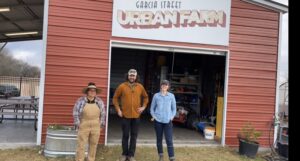
Garcia Street Urban Farm. Photo: Katherine Favor, NCAT
Garcia Street Farm, San Antonio, Texas
Garcia Street Farm is a 4-acre production and education farm in the middle of San Antonio that is utilizing alley cropping to improve the farm’s resiliency in the face of climate change, provide habitat for wildlife, and increase yield. This farm is a partnership between Alamo College and the San Antonio Housing Authority, and it primarily produces vegetables, cut flowers, and fruit.
Alley cropping is an agroforestry practice that consists of rows of trees interplanted with understory crops in the alleyways between tree rows. Alley cropping systems are great anywhere – not just in urban areas – but they are especially good for urban areas because they tend to “overyield,” meaning they produce more crops per acre than a monoculture would. In urban areas, which are often tight on space, alley cropping can help your farm produce more per acre than you otherwise would be able to. The trees in alley cropping systems also provide habitat for wildlife such as birds, bats, and insects, which is of huge importance, especially in urban areas where there isn’t usually much animal habitat. In areas impacted by both extreme heat and extreme cold, such as San Antonio, the trees in alley cropping systems provide shade for understory plants during the summer, while providing a buffer to cold wind during the winter. Stay posted for videos and publications about Garcia Street Farm to see exactly how they are using alley cropping to improve their farm resilience.
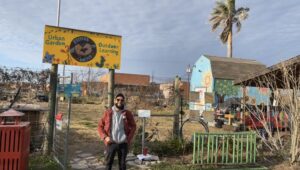
Keepers of the Garden. Photo: Katherine Favor, NCAT
Keepers of the Garden, Corpus Christi, Texas
Windbreaks are a common agroforestry practice consisting of one to three linear plantings of trees, typically planted on the perimeters of fields, to protect crops from wind and erosion. Windbreaks can be utilized in any space – urban or rural – to slow wind, provide privacy, buffer odors and pollution, function as wildlife habitat, and sometimes produce harvestable products.
Keepers of the Garden is a small production and education farm in the heart of Corpus Christi, Texas, and while this farm does contain a food forest, it has also utilized windbreaks around the perimeter of the farm. This farm is in the middle of the city and is surrounded by lots of buildings and busy streets, so these windbreaks, once fully grown, will function primarily as a privacy barrier and as a buffer to odors from the nearby road. In hot and humid climates such as Corpus Christi, species like Seagrape (Coccoloba Uvifera), make good windbreaks, as they grow tall and dense, have evergreen leaves for year-round wind protection, and provide harvestable fruit in addition to buffering wind. Stay posted for more videos about the other ways Keepers of the Garden has utilized trees in its urban agroforestry farm.
Photo: Katherine Favor 2022
Onion Creek Floodplain, Austin, Texas
The City of Austin is currently in the planning stage of a large urban agroforestry project in the Onion Creek Floodplain. This area has historically suffered many catastrophic floods, and it is predicted to suffer many more floods in the future. This area was previously occupied with residential housing, but the City bought out and demolished 815 homes and is now planning to restore the area. The goals behind this project are to: 1) protect the residents of Austin from flooding; 2) protect the environment from negative impacts of erosion; and 3) protect water quality. Utilizing trees in the form of urban agroforestry is one way to satisfy all these goals.
The first step in this project was to undergo an extensive process of community outreach and engagement to figure out what the community wanted to see done with this newly fallowed land. One idea the community expressed the most interest in was an urban agroforestry project – one in which edible trees would be planted in the area where houses once were. Trees are a great option for this space because this area is still in danger of future floods, meaning no permanent structures may be built in this zone. Trees, with their deep roots, have a better likelihood of withstanding future floods, and their fruits and shade could be enjoyed by the community when floods are not occurring. There are many stages in the planning process for a large-scale municipal restoration project such as this, but within a few years, the city of Austin may very well have a community food forest in the Onion Creek Floodplain.
These are just a few examples of folks in Texas who are utilizing urban agroforestry, but there are so many other ways to do it, too. NCAT is partnering with the USDA Agroforestry Center to create videos, podcasts, and publications about urban agroforestry, so stay posted for more resources on this topic soon. And reach out to an NCAT Sustainable Agriculture Specialist if you’d like to talk more about this one on one.
Related ATTRA Resources:
Episode 240. Urban Agroforestry for Dryland Environments
Episode 44. Opportunities in Agroforestry
Other Resources:
USDA National Agroforestry Center
This blog is produced by the National Center for Appropriate Technology through the ATTRA Sustainable Agriculture program, under a cooperative agreement with USDA Rural Development. ATTRA.NCAT.ORG.

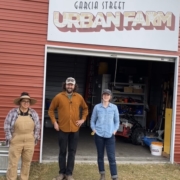
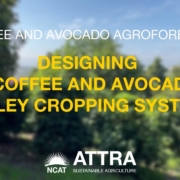

 Canva Pro
Canva Pro

